SUMMARY
This is AI generated summarization, which may have errors. For context, always refer to the full article.

MANILA, Philippines – The Philippines and the United States have agreed on four new local bases in the country where American troops will be allowed to build facilities and preposition defense assets, nearly nine years after both countries signed the Enhanced Defense Cooperation Agreement (EDCA).
Officials from the two countries made the announcement on Thursday, February 2, as US Defense Secretary Lloyd Austin visited the Philippines for the first time under the Marcos administration.
“Today, the Philippines and the United States are proud to announce their plans to accelerate the full implementation of the Enhanced Defense Cooperation Agreement with the agreement to designate four new Agreed Locations in strategic areas of the country and the substantial completion of the projects in the existing five Agreed Locations,” a joint readout said.
Philippine Defense Secretary Galvez declined to give details on where the four new EDCA sites were located, saying the coordination was still ongoing with local government units.
The announcement was met with protests outside the Philippine military headquarters, with militant activists demanding the Marcos administration scrap the military deal.
In a press briefing, Austin highlighted the message that the addition of new EDCA sites would not lead to a return of US bases in the Philippines. “We’re not seeking permanent basing,” he said.
Details on the specific locations of new sites were not immediately available, but Philippine officials earlier said locations being considered for access included Philippine bases in Northern Luzon and Palawan, sites near Taiwan, and the West Philippine Sea.
The five new EDCA locations are in addition to sites previously identified in March 2016, including Antonio Bautista Air Base in Palawan; Basa Air Base in Pampanga; Fort Magsaysay in Nueva Ecija; Lumbia Air Base in Cagayan de Oro; and, Mactan-Benito Ebuen Air Base in Cebu.
“The United States and the Philippines have committed to move quickly in agreeing to the necessary plans and investments for the new and existing EDCA locations,” officials said.
Strategic ally
The addition of new EDCA sites is the latest development after the two countries earlier agreed to strengthen military ties against the backdrop of rising tensions with China.
In a meeting between Galvez and Austin, the US reaffirmed that the two countries’ Mutual Defense Treaty would cover any attack in the South China Sea, where China continues to assert its claims in areas including Philippine waters.
“We remain committed to strengthening our mutual capacities to resist armed attack. This is part of our effort to modernize our alliance and these efforts are especially important as People’s Republic of China continues to advance its illegitimate claims in the West Philippine Sea,” Austin said, using the Philippines’ official name for its waters.
Experts and regional observers have been speculating in the past few months that the new EDCA sites would include bases located in Northern Luzon owing to the region’s proximity to Taiwan, which shares a sea border off the northernmost part of the Philippines.
Following increased tensions in the Taiwan Strait last August 2022, Philippine Ambassador to the US Jose Manuel Romualdez, a cousin of Philippine President Ferdinand Marcos Jr., said that Manila would let US forces access Philippine bases “if it is important for us, for our own security.”
High on Austin’s agenda while in Manila was “speeding up” the implementation of EDCA.
In a meeting with Marcos on Thursday morning, Austin continued to carry Washington’s message underscoring the Philippines as a “key” and “important” ally of the US, adding that their bilateral relationship should be further strengthened “in every way possible.”
“From the defense perspective, we will continue to work together with our great partners to build and modernize your capabilities,” he said.
Philippine and US defense officials said new EDCA bases would allow for more rapid support for humanitarian and climate-related disasters as well as response “to other shared challenges.”
“The Philippine-US Alliance has stood the test of time and remains ironclad. We look forward to the opportunities these new sites will create to expand our cooperation together,” officials said.
‘Missing piece’
Analysts had viewed the implementation of EDCA as a “big deliverable” in Philippine-US defense ties, pointing to the deal as essential for both countries to live up to their commitments under the Mutual Defense Treaty, which sees both sides commit to defend one another in case of an attack.
The Biden administration has been optimistic that defense ties with the Philippines could expand, after a turnaround seen under the final months of the previous Duterte administration, as well as the openness of a new Marcos administration.
The Philippines is also expected to see a boost in US military aid, with US officials allocating a potential $100 million in defense financing for the Southeast Asian country.
This would be on top of over $82 million already allocated toward infrastructure investments at the existing five sites under the EDCA and does not include funding from the US Department of Defense.
In November 2022, the Philippines’ Department of National Defense said the construction of EDCA projects in three more military bases was expected in 2023, after the US agreed to spend $66.5 million to start building training and warehouse facilities.
Like in the case of the Visiting Forces Agreement, then-president Rodrigo Duterte had threatened to scrap EDCA early in his term, saying he did not want to see soldiers of “any foreign power” in the Philippines.
Despite this, Duterte later upheld EDCA in a meeting with then-US president Donald Trump in 2017, though its implementation remained slow with the construction of just one site that began in 2018. – Rappler.com
Add a comment
How does this make you feel?



![[EDITORIAL] Paano tayo makakapuwing sa Tsina sa West Philippine Sea?](https://www.rappler.com/tachyon/2023/10/animated-wps-october-2023-carousel.jpg?resize=257%2C257&crop_strategy=attention)

There are no comments yet. Add your comment to start the conversation.